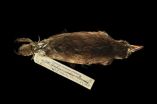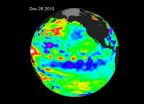(Press-News.org) BATON ROUGE – We live in a world almost completely dependent upon machinery. Since the creation of the simple wheel, humans have found ways to increase quality of life and advance scientific knowledge using these devices. Though the prevalence of machinery has allowed us to build bigger, travel faster and create more quickly with complexity increasing as science advances, our dependence upon them has limitations. Everything that moves can and will break, especially metals under strain. And when they fail, the consequences can be catastrophic. LSU's Michael Khonsari has developed and proven a novel method to avoid the danger that comes with reaching the breaking point.
Under the direction of Khonsari, Dow Chemical Endowed Chair in Rotating Machinery, the Center for Rotating Machinery in LSU's College of Engineering has developed a method to determine when metals under repeated back and forth stress will reach their breaking point. This discovery has the potential to save industry millions of dollars – and also save lives.
"It has far-reaching implications … this isn't going to impact just one industry or field," said Khonsari. "Machines impact our everyday lives, from automobiles to aviation, and breakdowns can cause immense complications. We're working to minimize those while maximizing efficient output."
The point at which materials reach a breaking point is a major concern. Chemical plants, for instance, rely on vast amounts of machinery to run efficiently and safely at all times. An emergency shutdown of just one piece of machinery could cost millions of dollars at best; at worst, it can cost lives.
"We have determined that most metals respond similarly when subjected to external cyclic stress that causes fatigue. While any kind of repetitive stress – bending, torsion, tension and compression – results in an increase in temperature, the moments before breakdown are precipitated by a sudden, drastic rise in temperature," said Khonsari. "What's more, we've determined that as a metal degrades, the amount of disorder generated within it keeps rising to a maximum value just before it fractures. And this maximum value happens to be a unique property of the metal. This discovery means we can anticipate the moment of failure and shut down before that moment arrives."
To reach these answers, Khonsari and his group had to go back to some basic questions and formulate their research in a totally new way.
"We had to ask ourselves those very fundamental questions. What is fatigue? What is wear? How to we characterize fatigue and wear? And is there a unifying principle behind all of these phenomena that basically cause degradation in a system? We had to start from the ground up."
He and his research team found that degradation results in disorder within a material and increases its entropy, a thermodynamic principle manifesting itself in an increase in temperature. They hypothesized that, at the moment of material failure, the total accumulated entropy is constant and independent of frequency, load or specimen size. The research was originally published in the Proceedings of the Royal Society of Mathematical, Physical & Engineering Sciences.
"The science base that underlies modeling and analysis of machine and structure reliability has remained substantially unchanged for decades. And unfortunately, a significant gap exists between available technology and science to capture degradation of machinery and provide early failure prediction," said Khonsari. "Fortunately, we were able to make significant strides toward closing that gap."
Using infrared cameras and cutting-edge computer technology, they ran tests analyzing bending and torsional stress of common metals such as aluminum and stainless steel. The thorough testing proved their hypothesis – the total accumulated entropy before fracture occurred was constant. In other words, it is a metal property. This led them to their next line of questioning.
"We essentially found an end to the life of certain materials in which you can monitor entropy accumulation to avoid catastrophic failure, so why not use this information to automatically stop the machine when the system reaches, say, 90 percent of its life?" said Khonsari. "Computerized monitoring systems and the algorithms and signal relay capable of doing so were all developed here at the Center for Rotating Machinery at LSU. Naturally, there was a process of trial and error, but it's all been tested and verified now. It's the real thing."
Because of the LSU College of Engineering's stature in industry in Louisiana and around the globe, Khonsari is confident that this research won't simply sit unused in a lab. It meets current industry needs. He knows, because the college meets with industry representatives on a regular basis to determine just that.
"The LSU College of Engineering's industry connections have been a huge help to us during every stage of this process," said Khonsari. "Research and development is not a quick process. There are many factors, including safety, that have to be considered and tested. Once we have tested it at LSU and feel confident that the product is up to par, it's a great advantage to then use it on a preliminary basis in industry situations so we can see how it performs outside the laboratory environment."
Khonsari submitted invention disclosures describing the technology to the LSU Office of Intellectual Property, Commercialization and Development and two patents are pending. The office is currently investigating licensing and commercialization opportunities.
"Before our venture into this area, research relating to fatigue was slow and incremental," said Khonsari. "Now, we're looking at potentially transformative new ideas. There are possibilities for this to be applied in nearly every aspect of our lives. Imagine being able to know before an airplane element breaks, a helicopter blade cracks or the brakes in a car fail. Things like this are possible through future applications of our work. And it all happened at LSU by a team of researchers at the Center for Rotating Machinery."
###
More news and information can be found on LSU's home page at www.lsu.edu
END
Dark energy is a mysterious force that pervades all space, acting as a "push" to accelerate the Universe's expansion. Despite being 70 percent of the Universe, dark energy was only discovered in 1998 by two teams observing Type Ia supernovae. A Type 1a supernova is a cataclysmic explosion of a white dwarf star.
These supernovae are currently the best way to measure dark energy because they are visible across intergalactic space. Also, they can function as "standard candles" in distant galaxies since the intrinsic brightness is known. Just as drivers estimate the distance ...
The following highlights summarize research papers that have been recently published in Geophysical Research Letters (GRL).
In this release:
Spooky action at a distance, for earthquakes
Evidence for water ice near the Martian equator
Extraordinary uplift of Yellowstone caldera
New evidence could let supereruption off the hook
Auroral oscillations seen on Saturn
How much sea-level rise can coastal marshes withstand?
Rain affects carbon-dioxide flow between sky and sea
Ionosphere model overshoots during solar minimum
Anyone may read the scientific abstract for ...
MANHATTAN, KAN. -- At any given time between 10 and 20 percent of cattle in the United States are afflicted with lameness, making it one of the most common ailments affecting feedlot and stocker calves.
That's why a Kansas State University research team is working to reduce the percentage of cattle affected by bovine lameness.
Three researchers -- David Anderson, professor of clinical sciences; Brad White, associate professor of clinical sciences; and Johann Coetzee, associate professor of clinical sciences -- are involved with bovine pain and welfare assessment at ...
BATON ROUGE – The Crab Nebula, once considered to be a source of energy so stable that astronomers used it to calibrate their instruments, is dimming. LSU physicists Mike Cherry, Gary Case and graduate student James Rodi, together with an international team of colleagues using the Gamma-ray Burst Monitor, or GBM, on NASA's Fermi gamma-ray space telescope, discovered the anomaly. This revelation has proven astonishing for astronomers.
The Crab Nebula, one of the most studied objects in the sky, is the wreckage of a star that exploded in 1054. Considered a cornerstone of ...
A research team from across the United States and Ecuador has pinpointed 1898 as the year the avipoxvirus, or avian pox, hit the Galapagos Islands and started infecting its birds. This estimation is vital to understanding avian diseases that affect today's Galapagos birds. The scientists' paper on the subject, "110 Years of Avipoxvirus on the Galapagos Islands," will be published on January 13 in PLoS ONE, an international, open-access science publication.
The research team, led by Dr. Patricia Parker of the University of Missouri–St. Louis, examined 3,607 finches and ...
A new Chandra X-ray Observatory image of Messier 82, or M82, shows the result of star formation on overdrive. At a distance of only 12 million light years, M82 provides a unique cosmic laboratory for studying conditions similar to those that existed billions of years ago when stars were forming at a furious rate in most galaxies.
M82 is a so-called starburst galaxy, where stars are forming at rates that are tens or even hundreds of times higher than in a normal galaxy. The burst of star birth may be caused by a close encounter or collision with another galaxy, which ...
DURHAM, N.C. — Researchers at the Duke Cancer Institute who have been studying prostate cancer cells for decades now think they know why PSA (prostate-specific antigen) levels reflect cancer progression.
"This is the first demonstration of a mechanism that explains why PSA is a bad thing for a tumor to produce," said senior author Sal Pizzo, M.D., Ph.D., chair of the Duke Department of Pathology. "I am willing to bet there is also a connection in cancerous cell growth with this particular biological signaling mechanism happening in other types of cells."
Using human ...
GALVESTON, TX – Drugs that pharmaceutical companies market most aggressively to physicians and patients tend to offer less benefit and more harm to most patients — a phenomenon described as the "inverse benefit law" in a paper from the University of Texas Medical Branch at Galveston.
Published online Thursday, Jan. 13 in the American Journal of Public Health, the article explores recent withdrawals of blockbuster drugs due to safety concerns and finds a clear pattern of physician-focused marketing tactics that ultimately exposed patients to a worsening benefit-to-harm ...
The American Heart Association today issued a call to action for the public, health professionals, the food industry and the government to intensify efforts to reduce the amount of sodium (salt) Americans consume daily.
In an advisory, published in Circulation: Journal of the American Heart Association, the association sets out the science behind the American Heart Association's recommendation for the general population, which is to consume no more than 1500 milligrams (mg) of sodium a day because of the harmful effects of sodium – elevated blood pressure and increased ...
New NASA satellite data indicate the current La Niña event in the eastern Pacific has remained strong during November and December 2010.
A new Ocean Surface Topography Mission (OSTM)/Jason-2 satellite image of the Pacific Ocean that averaged 10 days of data was just released from NASA. The image, centered on Dec. 26, 2010, was created at NASA's Jet Propulsion Laboratory (JPL), Pasadena, Calif.
"The solid record of La Niña strength only goes back about 50 years and this latest event appears to be one of the strongest ones over this time period," said Climatologist Bill ...


